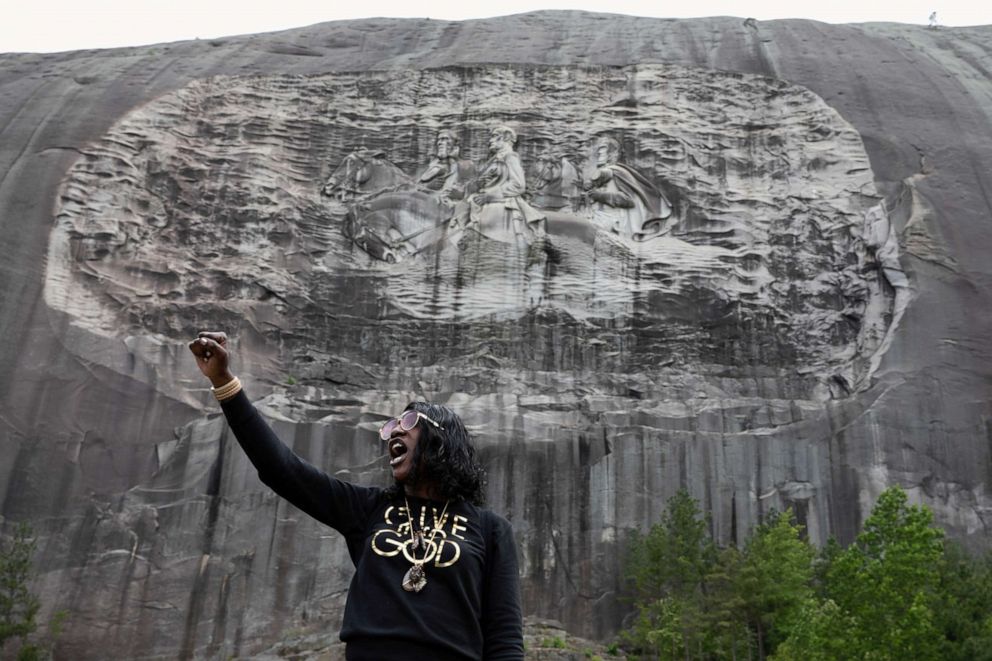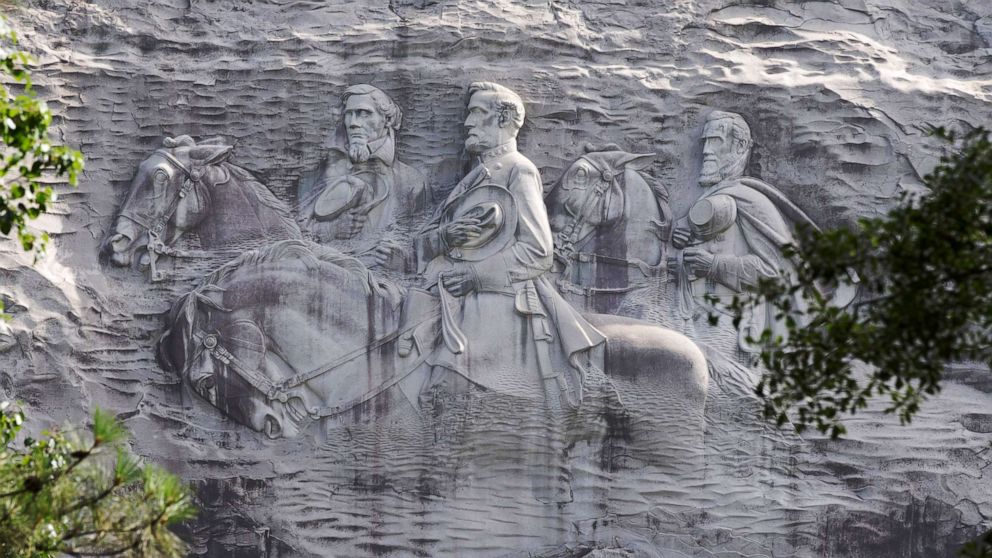Georgia activists seek to remove 'Stone Mountain', the 'granddaddy of Confederate monuments'
Stone Mountain Confederate Memorial, often called “the granddaddy of all Confederate monuments,” is once again at the center of an ongoing debate over a symbol that some see as a shrine of southern American heritage, and others see as a depiction of white supremacy etched into stone.
The fight over the monument, which is located in Dekalb County, Georgia, is unfolding as the U.S. grapples with civil unrest following the recent Black Lives Matter protests. Cities are being forced to reckon with a dark history, facing growing pressure to confront the racist past of confederate leaders honored in monuments across the country.
Though many statues and monuments have been quickly uprooted, both willingly by government officials or forcefully by protestors, monuments like Georgia’s Stone Mountain, the largest confederate memorial in the country which was christened with a cross burning when the Ku Klux Klan initiated 700 new members in 1948, are almost indelible.
The carvings of three Confederate leaders Gen. Robert E. Lee, General Thomas "Stonewall" Jackson and President of the Confederacy, Jefferson Davis sits 400 feet above the ground, which is larger than a football field. The memorial overlooks an outdoor recreational park and casts a shadow over Stone Mountain, Georgia, a predominantly black city.
Calls for racial equality have swelled in Georgia following the death of Ahmaud Arbery and Rayshard Brooks. As part of the growing movement, state officials are once again facing pressure to remove the controversial carvings engraved into the historic monument.
Viral video of a peaceful demonstration caused a stir on social media on July 4, when the Not F****** Around Coalition (NFAC), a self-proclaimed black militia group, led nearly 200 armed marchers in a protest that called for the removal of the memorial.
The Official Grand Master Jay, the NFAC founder, told ABC News he believes the Stone Mountain carving is a reminder of white supremacy, a history that cannot be cast simply as southern Confederate heritage.
“The United States has allowed it to exist but it's become a pain point. It's gotten to the point where it's more so fuel to the fire than it does to remind folks of their heritage. And of course, there are both sides to that, but I do believe that this particular monument is the pink elephant in the room,” he said.
Other organizations such as Black Lives Matter and the NAACP have also called for the removal of the monument.
Gerald Griggs, an African American civil rights attorney and vice president of the Atlanta NAACP, says the local chapter has marched on Stone Mountain over the last five years.
The organization spoke with the Stone Mountain Association on numerous occasions and has attempted to reach out to Gov. Brian Kemp about the possible removal of the Confederate monument, Griggs said.
“They don't believe that Georgia has the appetite to remove those symbols,” he said, explaining that state resistance comes as local county officials have recently voted to remove confederate flags and symbols in their cities.
“Several other counties are in the process of removing, so I think that there's a groundswell of support throughout the state to revisit this conversation,” Griggs added.

The “Granddaddy of Confederate Monuments"
The massive carving surrounded by a recreational theme park is just 19 miles outside of Atlanta, a major urban city where over 50% of the population is Black according to the U.S. Census.
In 1914, Helen Plane, a charter member of the United Daughters of the Confederacy, fought for a Confederate memorial carving honoring Southern Civil Leaders after their defeat in the Civil War. Gen. Robert E. Lee, Gen. Thomas “Stonewall” Jackson and President of the Confederacy, Jefferson Davis faces were carved detail-by-detail on horseback with hats over their hearts, according to author and historian David Freeman, who detailed the timeline of Stone Mountain in his book "Carved in Stone: The History of Stone Mountain." The sculpture is so grandiose it's often compared to Mt. Rushmore National Park in South Dakota.
“They intended it to be the granddaddy of all Confederate memorials,” Freeman said.
Freeman, who considers the carving environmental vandalism, says the monument perpetuates Confederate culture.
“People wanted to exploit it, even the KKK wanted to attach their name and their organization to it," Freeman told ABC News.
Decades later, the monument completed in 1972 is now Georgia's most visited attraction drawing nearly 4 million guests each year, according to the Smithsonian.
Griggs, a fifth-generation Georgian, says America needs to reevaluate its history.
“We have to talk about [the monuments] in their historical context. And to have the largest shrine to the Confederacy in the world in DeKalb County, which is a fairly diverse County, just one county over from the birthplace of Dr. King and the birthplace of civil rights, speaks volumes to hypocrisy.”
While thousands have called for the monument’s removal, experts from the Atlanta Geological Society say, it would cost millions to obliterate the carving with explosives due to its size and location.
There are also legal complications since Stone Mountain Monument has been under Georgia preservation since 2001. Georgia law states that “the memorial to the heroes of the Confederate States of America graven upon the face of Stone Mountain shall never be altered, removed, concealed, or obscured in any fashion.”
Freeman considers the monument ‘a remarkable achievement’ and it's unlikely it will be removed but suggests altering the nature of the park itself to contextualize the monument as a compromise.
“People of all races want to come to the park and enjoy it... and they can add a monument honoring the civil rights struggle to counterbalance the narrative,” he added.
However, Griggs says Georgians should not compromise their principles.
“When you talk about the enslavement of my forefathers, my ancestors, I'm not compromising,” Griggs said.




